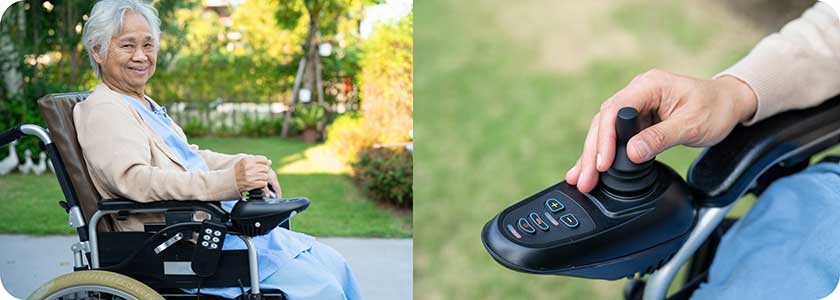Assistive Devices for the Elderly to Improve Quality of Life and Independence
Adaptive Well-Being With Assistive Devices For The Elderly
Advancements in technology are profoundly impacting how we all live, and seniors are no exception. Today, a vast array of assistive devices is available to offer older adults new ways to maintain their independence and well-being.
Do you feel elderly? The word may sound a bit funny to some of us, but that doesn’t change our groaning when we have to get out of a chair we’ve been sitting in for slightly too long. Let’s face reality, a few complaints here and there don’t make us consider ourselves senior citizens, but little by little, we are all getting older, and some of us will need a little cool high-tech help to get us through the day. If not today or tomorrow, it’s still something to keep in mind.
For many who are aging, performing routine tasks can become a barrier to independent living. Assistive and adaptive devices and senior-focused technology solutions can do a lot to help restore autonomy and confidence.
The range of available options is broad and adaptable to individual needs. These tools address a wide range of challenges faced by seniors, from managing everyday tasks to staying connected. They can improve mobility and safety during everyday activities and adventures, in some cases offering cognitive support or medication reminders. Technology of this type can be as simple as rubber grips to support walking stability, or as sophisticated as advanced in-home systems that connect with loved ones.
Technology of this type also provides emotional and social benefits. By reducing dependence on others, aging individuals can enjoy a more active, engaged lifestyle, improving their overall well-being. This is not only a gamechanger for day-to-day senior life, but also alleviates pressure on caregivers and family members.
Assistive and adaptive technology is more than a trend. It’s a much-needed solution for many, especially as the global population ages. A United Nations report projects that the number of people aged 65 or older will reach 1.5 billion by 2050. Assistive technology offers a path for seniors to live safely and confidently at home for longer (or what’s called aging in place), and its value to those in assisted living or care situations cannot be overstated.
Technology To Help Seniors Live Safely and Independently

Assistive technology offers a wide range of devices designed to help provide support for seniors in their daily activities, and to amplify their quality of life. Here's a look at some examples:
Mobility
Canes, walkers, and state-of-the-art wheelchairs provide essential support for movement, so seniors can navigate their surroundings safely and stay active. These adaptive devices for elderly people are, of course, also used by individuals of all ages who have mobility issues.
While simpler canes cannot be underestimated, high-tech canes with built-in LED lights for nighttime safety such as the Doosl Walking Cane, shock-absorbing handles for comfort, and foldable designs for easy portability are a really useful advanced option. And, stable tripod cane bases or tips are a great stabilizing addition to any cane.
The HurryCane Freedom Edition Foldable Walking Cane is a great choice, appreciated most for its SteadiGrip base design, which provides three points of contact for maximum balance and support, and the KingGear Adjustable Cane is another excellent balance-focused option, with a 120º rotating quad-tip base. One more popular option: the Equate Quad Cane.
Rolling walkers with comfortable seats, three- and four-wheel options for different stability needs, and hand brakes for additional control are helpful. Top choices include the NOVA Lightweight Walker and the Drive Medical Nitro Deluxe Rollator Walker (foldable).
For lightweight, electric wheelchairs with adjustable seating positions, joystick controls for easy maneuverability, and obstacle-detecting sensors, many choose the Pride Mobility Go-Go LX, or the Merits P-320 Power Wheelchair.
Hearing
Hearing aids and amplifiers improve the hearing capabilities of those with hearing loss, making communication clearer and facilitating better engagement in social activities.
Discreet, behind-the-ear (BTE) hearing aids with directional microphones to focus on speech in noisy environments, rechargeable batteries for long-lasting use, and smartphone connectivity for adjustments include such popular choices as the Phonak Audéo Paradise, the Oticon More range, and the Signia Styletto 3X.
Personal amplifiers with adjustable volume controls, neck loops to connect directly to sound sources, and built-in background noise reduction features that are favorites for our users include the Hamilton CapTel Big Button Phone with amplified handset, the Bellman & Symfon Mino Personal Amplifier with Headphones, and the Williams Sound Pocketalker for television listening.
Vision
Digital screen readers and voice recognition software make computers and smartphones more accessible for those with vision impairments. They transform text into verbal announcements and allow for voice-controlled interaction, keeping users connected and informed. Some popular options offer OCR (Optical Character Recognition) technology to read physical documents aloud as well. Screen reader favorites for many are NVDA and JAWS, and Microsoft Narrator with OCR. Dragon NaturallySpeaking and Apple’s Siri are two voice recognition applications that many recognize or already use.
Home Safety
Emergency response systems, motion sensors, automated lighting, smoke detectors, medical alert systems, and automatic appliance shut-off features contribute to a safer living environment, giving peace of mind and helping to prevent accidents. Philips Lifeline products, Lively Mobile Personal Alert Systems, Bay Alarm Medical and Medical Guardian devices, and Philips Hue Motion Sensor with Smart LED Bulbs are some of the choices we’ve seen recommended. The Ring Indoor Cam, with motion detection and night vision, integrates with Google Assistant and Alexa, has high video storage, and offers a person detection add-on option.
Digital Accessibility
Design elements like larger fonts, increased contrast, and simpler layouts on websites and apps, along with web accessibility overlays, make digital platforms more user-friendly for seniors. While accessibility for users with disabilities as well as the elderly population should be considered as part of universal design principles, they aren’t always. Plugins and overlay tools can help adapt websites and apps to be more readable and navigable, improving accessibility without comprehensive redesigns, so that seniors can comfortably access information and services online. While design elements and principles are available as software, we’ll leave that for the designers, and simply mention the WebAIM WAVE Toolbar, Userway Accessibility Widget, and the Read Aloud Text-to-Speech Chrome extension.
Wearable Technology
Gadgets like smartwatches and fitness trackers can monitor vital health metrics such as heart rate and blood pressure. These devices worn on the body monitor vital signs and manage chronic conditions, assisting seniors and their caregivers in keeping track of health conditions, and offering the possibility of early intervention when necessary. A few such popular smartwatches: Apple Watch Series 8 with ECG, Fitbit Sense 2 with stress management tools, and the Samsung Galaxy Watch5 with advanced sleep tracking. And, fitness trackers we’ve used include the Xiaomi Mi Band 7, the less successful Amazon Halo View, and the Amazfit Bip 3.
Telehealth and Remote Patient Monitoring
These technologies allow for virtual consultations with doctors, medication reminders, and remote health condition monitoring. They reduce the necessity for frequent in-person hospital visits, which is particularly beneficial for seniors, allowing them to receive care and consultations from the comfort of their homes. Because these are sensitive technologies and services that must be secure and may only be available in certain circumstances, we offer no recommendations except that each individual consult their doctor or medical health professional, or ask family and friends for their recommendations.
Each of these assistive technologies has a vital role, offering solutions that promote independence, safety, and well-being. As the population ages, the importance of these devices continues to grow, highlighting the need for ongoing development and accessibility in this field.
Overcoming Challenges In Adapting to New Technologies

While assistive technology offers a wealth of benefits for seniors, some may face hurdles in adopting these devices, including unfamiliarity with recent digital advancements, and sometimes, diminished cognitive or physical capabilities. Unfamiliarity with new technology can be daunting, and complex interfaces can cause frustration. Physical limitations such as reduced dexterity or vision issues can make it difficult to operate certain devices. And, even for those of us who don’t think of ourselves as seniors yet, keeping up with the ever-changing tech landscape can be overwhelming.
What’s the answer? There are two, and they should be used together. User-friendly design and proper training are key to overcoming these challenges.
Simple interfaces with large buttons, clear instructions, voice commands and touch interfaces can significantly improve accessibility. Personalized training sessions that address individual needs and learning styles can be critical in many situations. Training goes beyond simply explaining how a device works. It should provide ongoing support and guidance, checking in with seniors to make sure they feel comfortable using technology in their daily lives.
This dual approach, when properly implemented, means seniors can feel confident using new technology, and enjoy the benefits it offers for independent living.
Keeping Seniors in Step with Innovation
Assistive technology presents a wide array of powerful solutions for seniors seeking to maintain independence and a high quality of life. From mobility aids to digital tools, these devices address everyday challenges and offer ways for seniors to stay connected, safe, and engaged in their communities, empowering them to navigate the challenges of aging with confidence. As technology continues to evolve, user-centered design and accessible interfaces will remain pivotal for seniors to fully embrace the potential of these advancements.
FAQs
Yes, some wearable technologies are equipped with fall detection features. These devices can automatically alert emergency services or designated contacts if a fall is detected, providing an added layer of safety.
Various programs and organizations offer financial assistance for seniors needing assistive technology. These might include government initiatives, nonprofit organizations, or insurance coverage options. Eligibility and availability can vary by region and individual circumstances.
The maintenance requirements for assistive devices in general and for elderly users will vary depending on the type and complexity of the technology. However, many devices are designed with ease of use in mind, requiring minimal maintenance. Manufacturers and suppliers often provide support and service packages to assist with any technical needs.
Many senior centers, community organizations, and libraries offer workshops and resources on assistive technology. Online resources from reputable government agencies, aging advocacy groups such as AARP, and the National Council on Aging also provide helpful information.
Yes! Many devices prioritize user-friendliness. Look for features like large buttons, voice controls, and clear instructions. Also, in-home training sessions can help you get comfortable using new technology.









